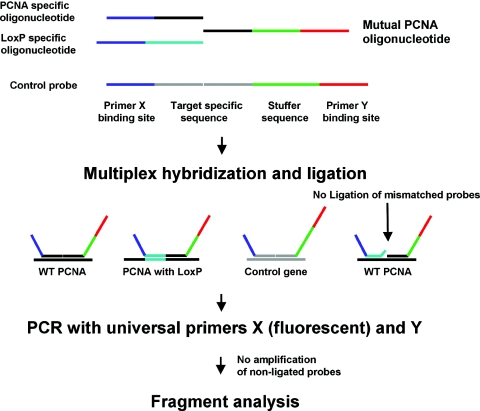Figure 1.
Principle of adapted MLPA. For the targeted PCNA gene, two MLPA probes specific for either the 5′ or 3′ LoxP sequence were designed, each consisting of three oligonucleotides: one synthetic mutual PCNA specific 5′ phosphorylated oligonucleotide, one synthetic PCNA specific and one synthetic LoxP specific oligonucleotide. The short synthetic oligonucleotides consist of a 5′ universal primer sequence X, a short stuffer sequence and a target-specific 3′ sequence. The mutual PCNA specific oligonucleotide consists of a 5′ target-specific sequence designed to hybridize in juxtaposition to the synthetic oligonucleotides and a 3′ universal primer sequence Y. In addition, for copy number quantification 12 ordinary MLPA probes consisting of two oligonucleotides, one short synthetic and one longer phage M13 derived (with different stuffer lengths), each specific for different genes in the mouse genome. After denaturing the sample DNA the probe oligonucleotides are hybridized overnight to their respective targets. Only perfectly matched probes are ligated by the thermostable Ligase-65 and only ligated probes are exponentially amplified by the universal primer pair X and Y in the subsequent PCR. Finally, the amplified fragments are separated and analysed by capillary electrophoresis.

